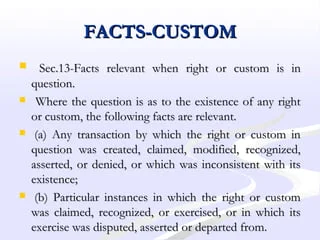- Any transaction by which the right or custom in question was created, claimed, modified, recognized, asserted, or denied, or which was inconsistent with its existence. This could include deeds, contracts, agreements, or other legal documents. It could also include historical records, such as government reports, newspaper articles, or diaries.
- Particular instances in which the right or custom was claimed, recognized, or exercised, or in which its exercise was disputed, asserted, or departed from. This could include testimony from witnesses, who can describe how the right or custom has been treated in the past. It could also include evidence of physical acts, such as the construction of a fence to mark a property boundary or the use of a common grazing area.
Section 13 of Indian Evidence Act – The following are some examples of Facts relevant when right or custom is in question :
- Example 1: A landowner claims the right to fish in a river that runs through their property. To support their claim, they produce a deed from 100 years ago that grants their ancestors the right to fish in the river. They also testify that they and their family have been fishing in the river for generations without objection from anyone.
- Example 2: A village claims the right to use a common grazing area. To support their claim, they produce evidence that the villagers have been using the grazing area for over 100 years. They also testify that the villagers have a system for managing the grazing area, such as rules about how many animals each villager can graze.
- Example 3: A company claims the right to pollute a river. To support their claim, they produce a permit from the government that allows them to discharge a certain amount of pollution into the river. They also argue that they have been polluting the river for many years without any complaints from anyone.
In each of these examples, the court will consider the relevant facts to determine whether the right or custom in question exists. The court will also consider any other relevant factors, such as the law and public policy.
It is important to note that not all facts are relevant when determining whether a right or custom exists. For example, the court will not consider facts that are too remote in time or that are irrelevant to the issue at hand. The court will also not consider facts that are hearsay or that are otherwise unreliable.
If you are involved in a legal proceeding where the question of a right or custom is in issue, it is important to gather all relevant evidence to support your claim. This may require consulting with a lawyer or other legal expert.
Case Law: Section 13 of Indian Evidence Act
Bettison and Others v. Langton and Others (2001) UKHL 29
Facts:
The commoners of the Manor of Ambleside claimed a right to graze their animals on a common called Loughrigg Fell. The lord of the manor argued that the commoners only had a right to graze a limited number of animals on the fell.
Issue:
Did the commoners have a right to graze their animals on Loughrigg Fell?
Law:
Under English law, commoners have a right to graze their animals on a common. However, the lord of the manor can regulate the commoners’ grazing rights.
Analysis:
The House of Lords considered the following factors to determine whether the commoners had a right to graze their animals on Loughrigg Fell:
- The history of the common.
- The terms of the grants that created the common.
- The way that the common has been used in the past.
The House of Lords found that the commoners had a right to graze their animals on Loughrigg Fell. The House of Lords held that the lord of the manor could not regulate the commoners’ grazing rights.
Conclusion: Section 13 of Indian Evidence Act
The commoners had a right to graze their animals on Loughrigg Fell.
Holding:
The House of Lords allowed the commoners’ appeal.
This case is relevant to the case of the village that claims the right to use a common grazing area. The case establishes that commoners have a right to graze their animals on a common, even if the lord of the manor tries to regulate the commoners’ grazing rights.
If the village in the case that you described can prove that they have been using the common grazing area for a long time, and that they have a system for managing it, then they are likely to have a right to use the grazing area, even if the government has not granted them a permit.

